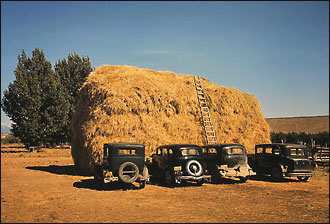The Color of America
Library Displays Rare Depression-Era Photos

Beginning in 1935, the U.S. government dispatched photographers to rural and small-town America to document the living conditions of the poorest of the poor. People with dirt on their fingernails and mud on their walls. People who worked the fields and sometimes went to school barefoot. It was the height of the Depression, after all, and Washington, under the auspices of the Farm Security Administration, was looking for ways to drum up support for its relief programs.
Most of the project’s 170,000 images were shot in black and white. But a handful, roughly 1,600, were also captured in color following the introduction of the Eastman Kodak Company’s new Kodachrome film in the mid-1930s. Now, 70 of these color photographs, many of which have languished unseen for years in the Library of Congress’ archives, have been plucked from obscurity for the exhibit “Bound for Glory: America in Color, 1939-1943,” opening today in the Library’s Thomas Jefferson Building. [IMGCAP(1)]
While the black and white pictures were distributed to newspapers and magazines throughout the country to publicize the plight of the Depression’s victims, the color versions were undertaken more as “an experiment to see if it worked,” said LOC Curator of Photography Beverly Brannan. “They were kind of forgotten. People didn’t take color pictures seriously until the 1970s. They were associated with postcards and family snapshots.”
In retrospect, however, these exquisitely natural color photographs, lacking the super-saturated, hyped-up colors of much modern photography, come across as high art. The images, of a dirt-streaked family sitting down to a humble repast or of tenant farmers lined up to receive surplus crops, are hauntingly iconic — and hardly without hope. There is a quiet dignity to the scenes, a sense of solidarity and resilience that shines through the bleakness. Amid hardship, the families are still eating together. The women are still painting their fingernails.
The FSA project was carried out under the direction of Roy Stryker, who trained as an economist and engineer and had little experience as a photographer. But Stryker was an excellent administrator. He assigned a strict regimen to his photographers, which included reading a cultural geography textbook, attending briefings and undertaking day-trips to photograph in the Washington, D.C., area before being sent into the field to carry out their work.
The job of accumulating what writer Paul Hendrickson termed “a pictorial encyclopedia” wasn’t easy, often requiring photographers to be artist, cultural anthropologist and diplomat (sometimes sociologists even advised them). For instance, Marion Post Wolcott, one of the project’s rare female photographers, served as the unofficial “goodwill ambassador” to much of the Southern United States, where resistance to the intrusion of the mainly Northern government photographers, and the federal programs and modernity they represented, was especially acute, Brannan said.
“She was sent to all the trouble spots in the South to make pictures,” explained Brannan. As a woman, Brannan added, Wolcott was viewed as something of an anomaly in many Southern areas where female roles were more limited and conservative mores predominated.
Once the photographers got into the field, the project expanded to include “a survey of all the activities” that were part of small-town quotidian life, Brannan noted. “They realized the small towns weren’t going to be there much longer.” They also broadened their scope to include more emphasis on urban life, and later on the war effort.
Some of the pictures offer undiluted Americana, straight out of Huck Finn, “Little House on the Prairie” or Grant Wood’s “American Gothic.” Cases in point: Wolcott’s young boys in straw hats fishing on a Louisiana bayou, and Russell Lee’s images of Pie Town, N.M., homesteaders and of Oklahoma children asleep on a bed during a square dance.
Other photos display a surprisingly modernistic edge. There are visual puns — jalopies humorously captured against a wall of hay — and plenty of shots of roadside gas stations and vanishing mom-and-pop stores with their iconic hand-lettered signs juxtaposed against the encroaching commercialism of mass-produced advertising.
With Pearl Harbor, however, came a distinct shift in tone. The spare, often gaunt, Depression-era America got in touch with its fighting side. And the pictures, accordingly, turned patriotic.
“They were selling the product of a strong United States,” said Brannan. From 1942 onward, many of the photos depict America in action — a world of “monumental machines” and the industrious humans who worked on them. There are hardy, Rosie-the-Riveter-style factory women and precocious young farm boys, who “looked like … the kind of people to defend you when they grew up,” Brannan noted.
At the same time, dissatisfaction with Stryker, largely from Southern politicians never pleased with the initial aims of the FSA’s photographic project, was mounting. President Franklin Roosevelt needed their support for the war more than he needed “to shield” Stryker. In the early 1940s, the FSA’s photographic unit was transferred to the nascent Office of War Information. And by 1943, Stryker had resigned to head up a Standard Oil photographic project aimed at publicizing the importance of oil to America and its war effort.
“Bound for Glory: America in Color, 1939-1943,” will be on view through Nov. 26 in the South Gallery of the Great Hall of the Library of Congress’ Thomas Jefferson Building. For more information, go to www.loc.gov/exhibits.





